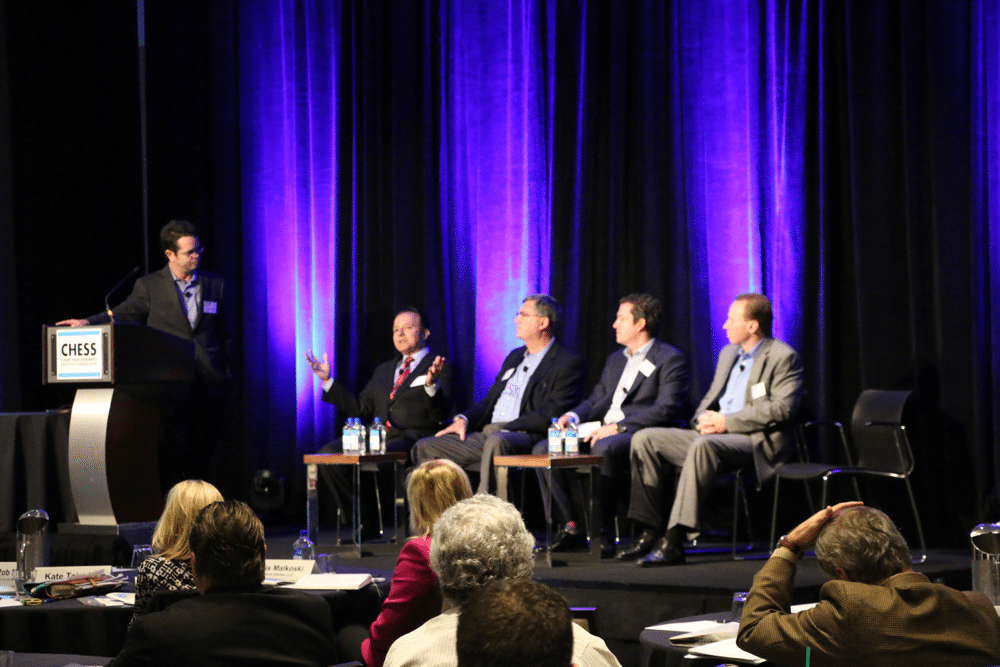Chief Housewares Executives Gather at Annual Strategic Senior-Level Conference
Tuesday, October 7, 2014
By Vicki Matranga, Design Programs Coordinator
Chief housewares executives eager to hear the latest from the front lines of the industry learned from experts who addressed IHA’s annual CHESS conference October 7 and 8. The two-day conference, held at the Loews Chicago O’Hare hotel, attracts top executives at IHA-member companies who look forward to the varied and fast-paced program. Eight presentations and panel discussions presented the state of the practice and offered high-level insights into design and innovation, digital commerce, social media, capital acquisition, retail trends and more. This engaging and exhilarating conference joins veteran and first-time participants who value building relationships that help build their businesses.
Day One: Session One
Housewares Hot Seat—Securing Your Place Along the Purchase Path
The morning began with a conversation moderated by Peter Giannetti, Editor-in-Chief, HomeWorld Business with panelists Richard Boynton, President, Jura Inc.; AJ Khubani, CEO/President, TeleBrands Corp.; Brian Melzer, President, Epoca International Inc. and Jay Zilinskas, Managing Director, Meyer Corporation. They discussed leading-edge B2B and consumer marketing strategies to engage and convert buyers along today’s multi-channel path to purchase. The panelists outlined how they
- Win more favorable in-store and digital commerce positions
- Deploy impactful, cost-effective media campaigns
- Optimize alternative channels of distribution
Giannetti set the stage with the key question: “Who is your customer? Once we sold to the retailer, now we sell to and engage with the consumer.” He asked about the state of the market, touching upon the differences between communication channels directed toward retailers and consumers. With many touch points, cohesive strategies become more critical to deliver the same message across all platforms. Today 80% consumers learn online first and go to stores to purchase.

Khubani: As a direct marketer, Telebrands built its business to consumers first and retail followed. The 2008 economic collapse propelledour As Seen on TV business because TV ad rates dropped and our infomercials were able to reach more consumers. This pulled retailer interest, so our methods of selling direct to consumers had to change. Existing customers tell us what to introduce—they are our market research. Companies need to choose which sites to use for one-to-one communication. Ecommerce builds bricks and mortar growth.
 Boynton: JURA Capresso is a Switzerland-based, coffee and tea-focused company with two distinct markets: Jura offers high-end, sophisticated products to specialty stores and primarily male consumers; Capresso sells through more mass distribution to female users. We use different strategies for each brand. For Jura: print advertising and public relations drives sales. Purchasers of expensive products demand premium customer service. Jura’s successful accessories and parts business continues relationships with users. Social media is more important for Capresso. Coffee and tea specific websites are valuable to both brands.
Boynton: JURA Capresso is a Switzerland-based, coffee and tea-focused company with two distinct markets: Jura offers high-end, sophisticated products to specialty stores and primarily male consumers; Capresso sells through more mass distribution to female users. We use different strategies for each brand. For Jura: print advertising and public relations drives sales. Purchasers of expensive products demand premium customer service. Jura’s successful accessories and parts business continues relationships with users. Social media is more important for Capresso. Coffee and tea specific websites are valuable to both brands.
Melzer: Epoca is a growing young company that offers innovative products to digitally savvy users. We seek opportunities in large retailers  and individual consumers at the same time. There is no linear path to purchase; we aim for discovery, interaction and engagement—engagement leads to repeat sales. How to establish your position? With a great product that lives up to consumer demands. Consumers believe what other people are saying about your brand more than what you say about your products. Communicate your story clearly and tell same story in bricks and mortar stores and online. We want to move our purchasers “from like to love” and become our advocate.
and individual consumers at the same time. There is no linear path to purchase; we aim for discovery, interaction and engagement—engagement leads to repeat sales. How to establish your position? With a great product that lives up to consumer demands. Consumers believe what other people are saying about your brand more than what you say about your products. Communicate your story clearly and tell same story in bricks and mortar stores and online. We want to move our purchasers “from like to love” and become our advocate.
 Zilinskas: Meyer is an established company with many cookware brands that rely on innovation and creativity. Our cookware has patented features to differentiate brand identities targeted to user segments. We communicate directly with digitally aware shoppers. Millennials have growing buying power and influence. They seek authenticity and consistency and don’t want to be spoken to–they want to participate in the brand. In the complicated evolution between bricks and mortar stores and online we try to bring the online experience to the store. You have to review your strategies as old world tactics meet new world tactics. We opened up free-standing brand websites to educate shoppers with information and demonstrations. These websites also teach retailers how we position our brands. Data shows when consumers come to the site, most don’t buy, but the website directs them to retailers.
Zilinskas: Meyer is an established company with many cookware brands that rely on innovation and creativity. Our cookware has patented features to differentiate brand identities targeted to user segments. We communicate directly with digitally aware shoppers. Millennials have growing buying power and influence. They seek authenticity and consistency and don’t want to be spoken to–they want to participate in the brand. In the complicated evolution between bricks and mortar stores and online we try to bring the online experience to the store. You have to review your strategies as old world tactics meet new world tactics. We opened up free-standing brand websites to educate shoppers with information and demonstrations. These websites also teach retailers how we position our brands. Data shows when consumers come to the site, most don’t buy, but the website directs them to retailers.
In closing, the panelists agreed that companies must be nimble and management must be highly educated. The sand under our feet is shifting daily. Retailers expect us to educate the salespeople and the consumers.
Get acquainted with the panelists here:






